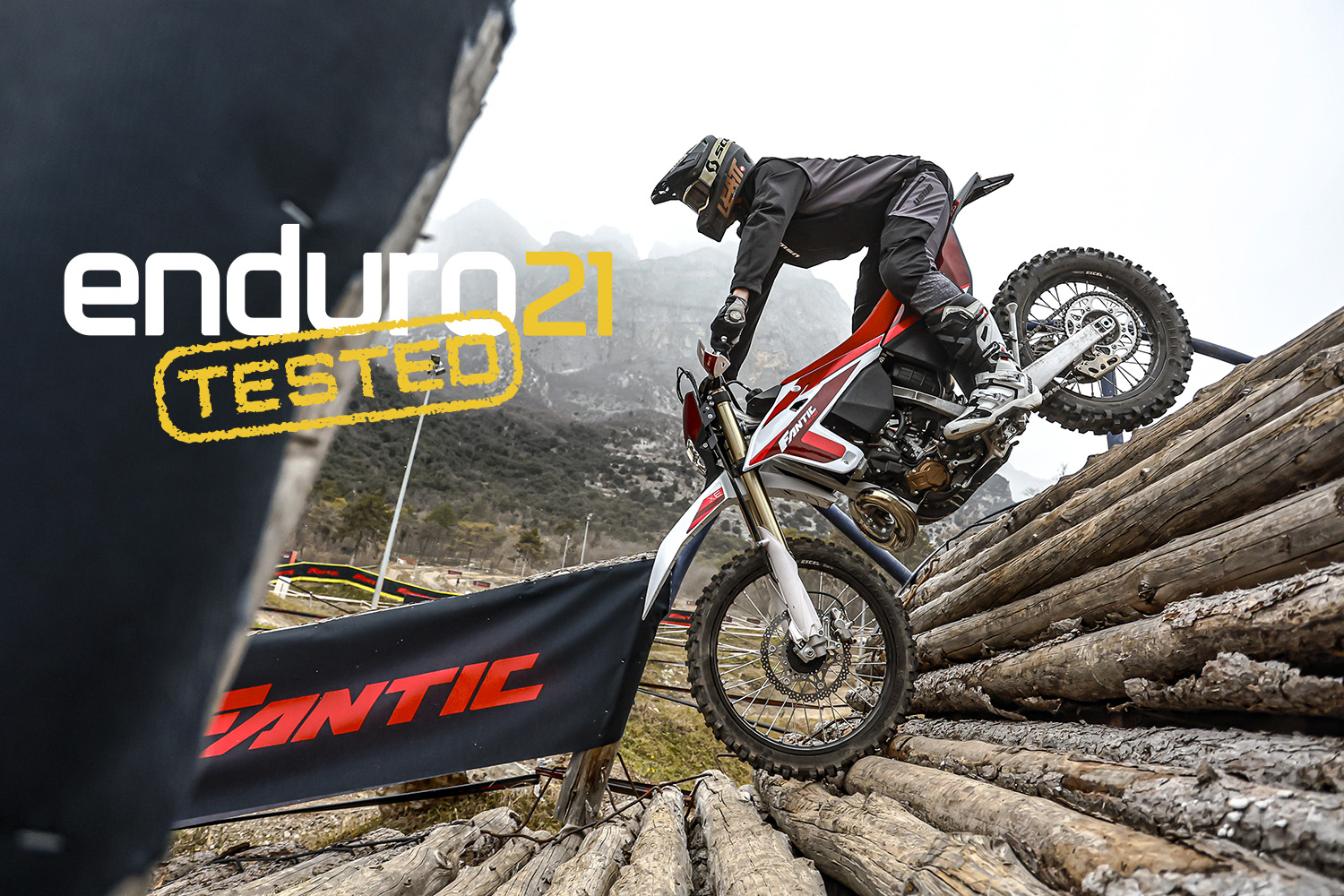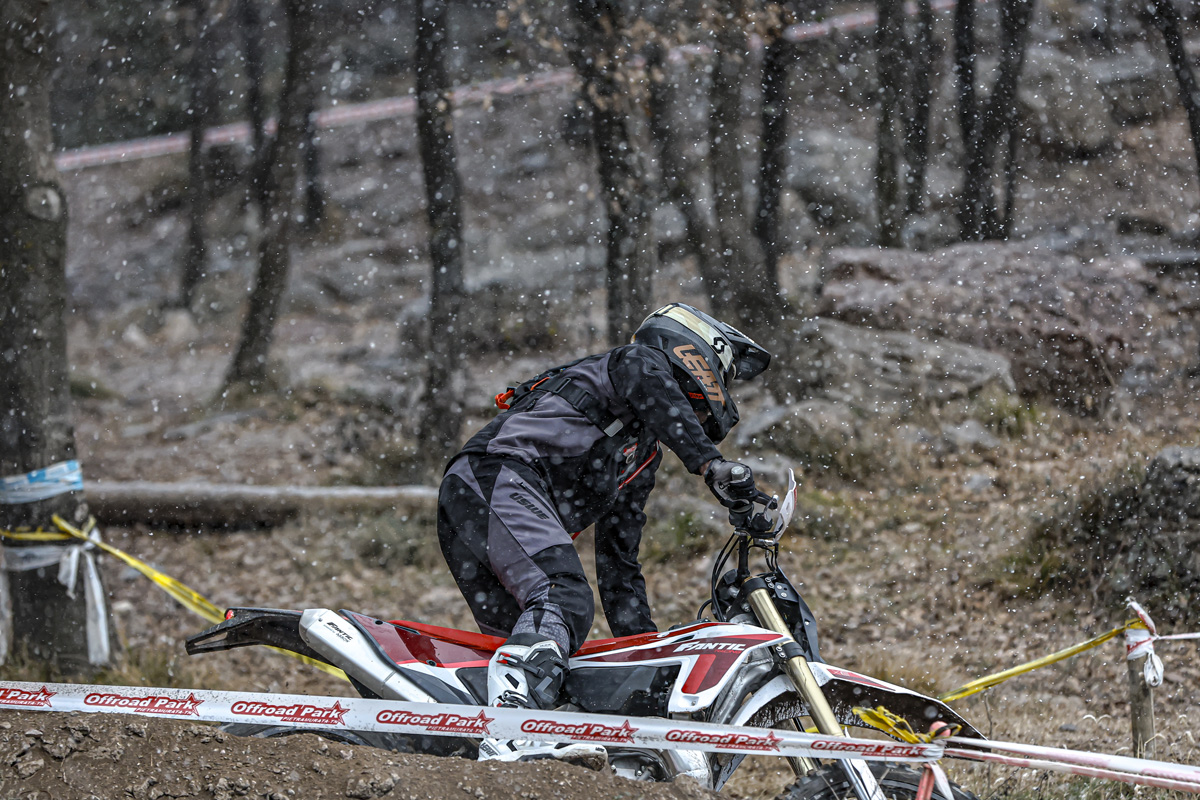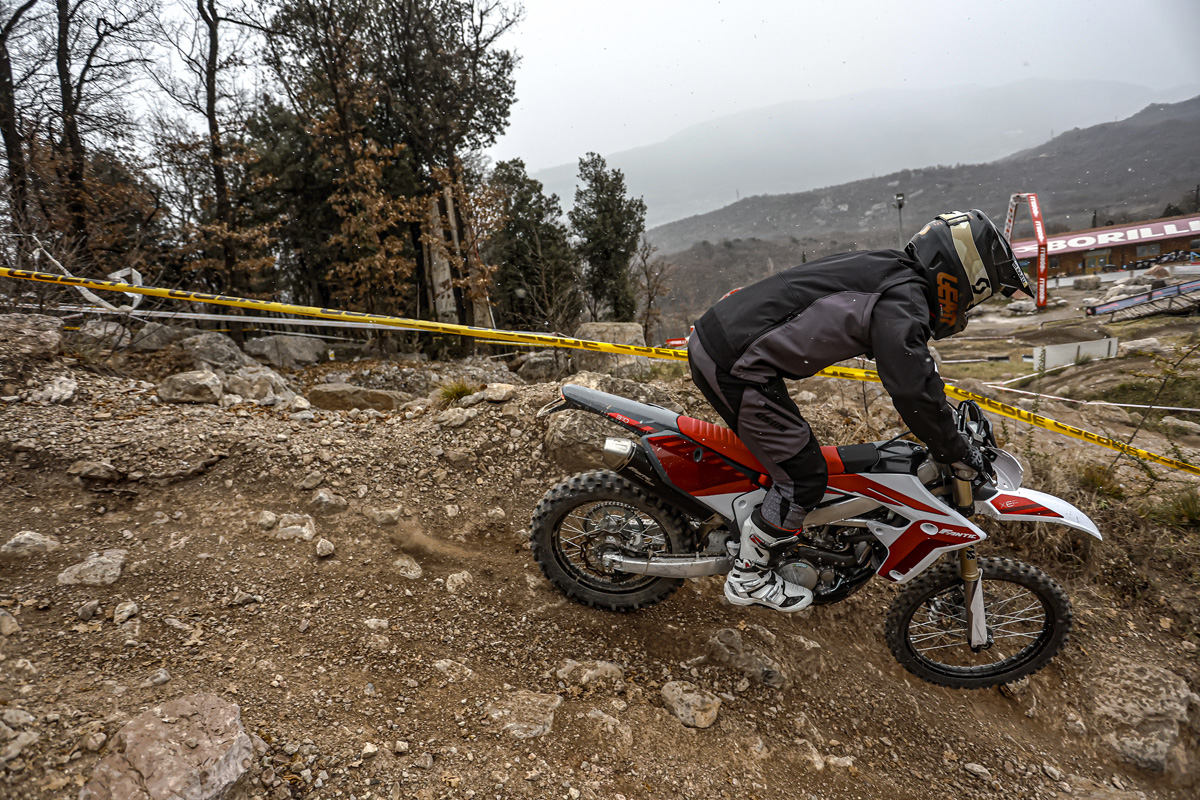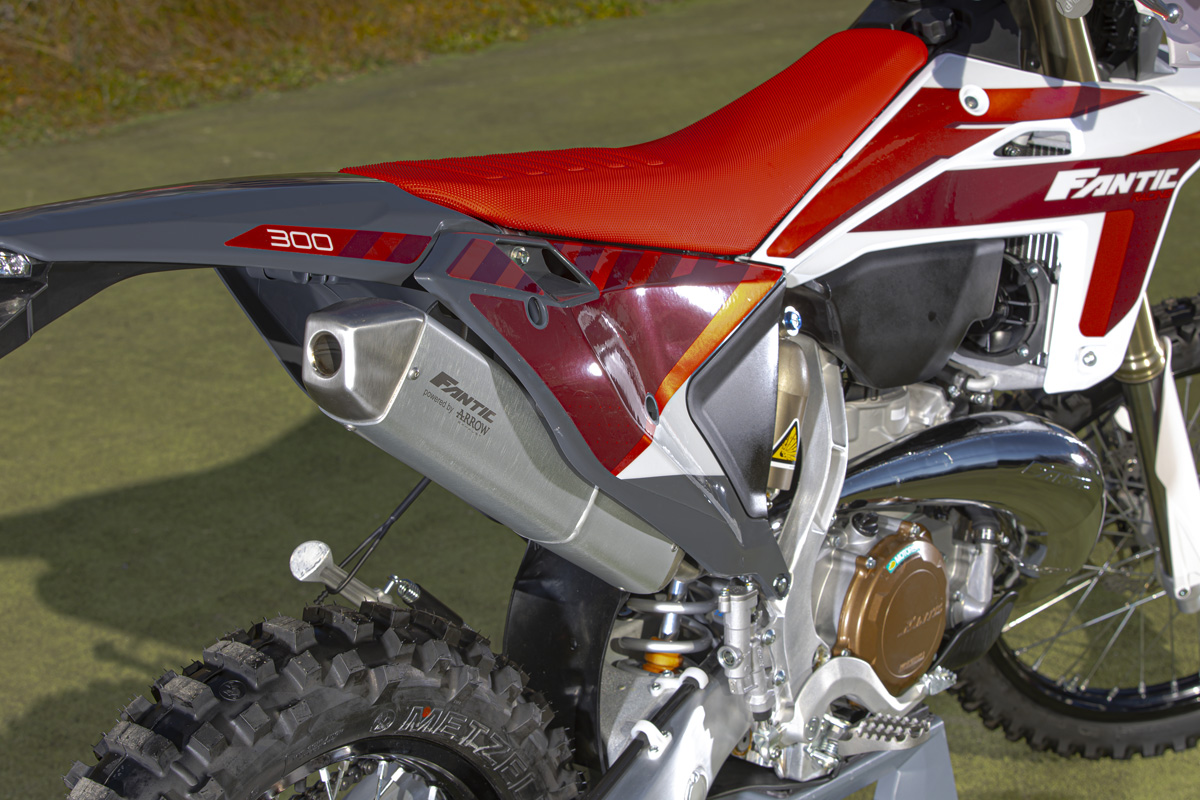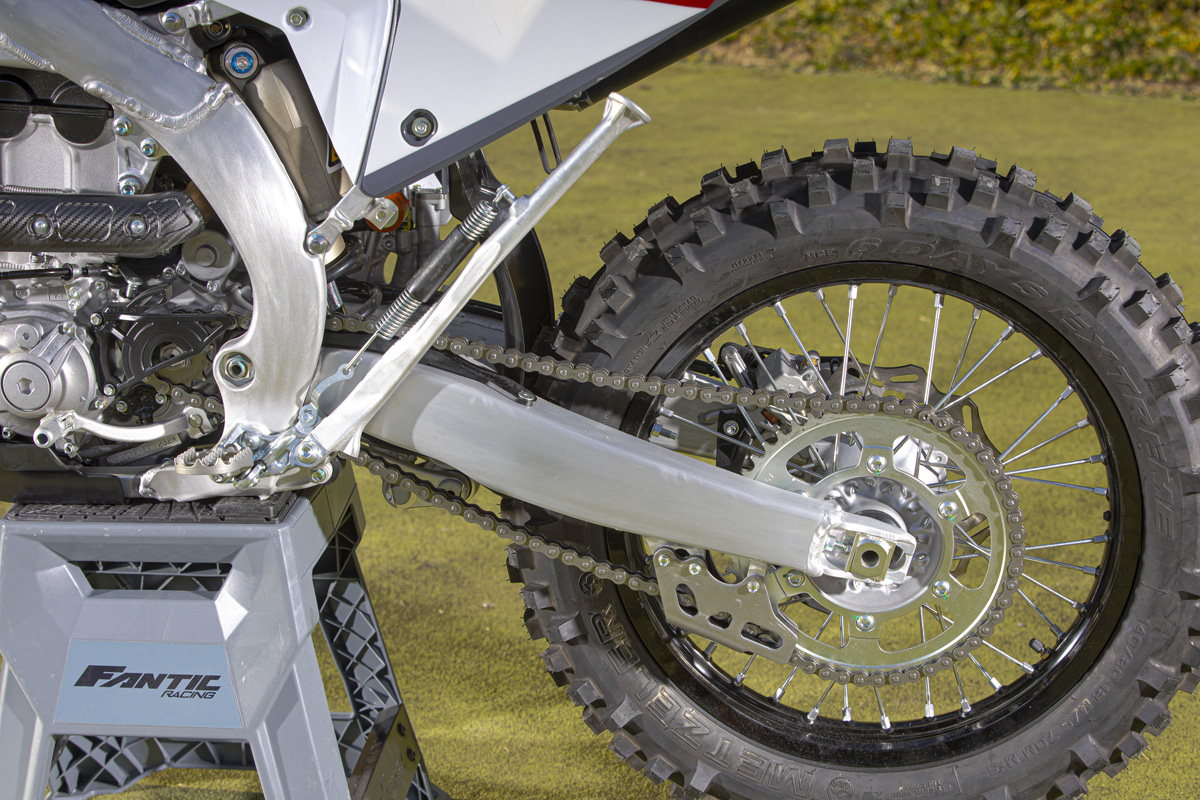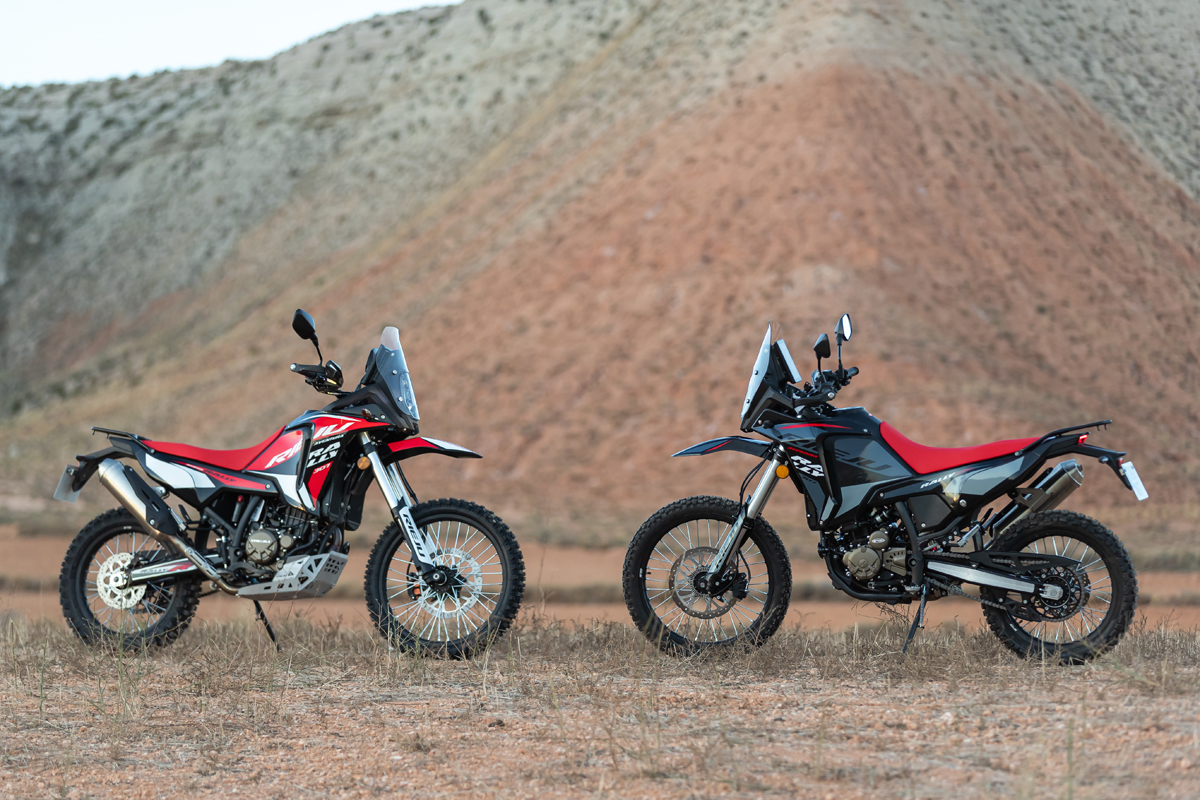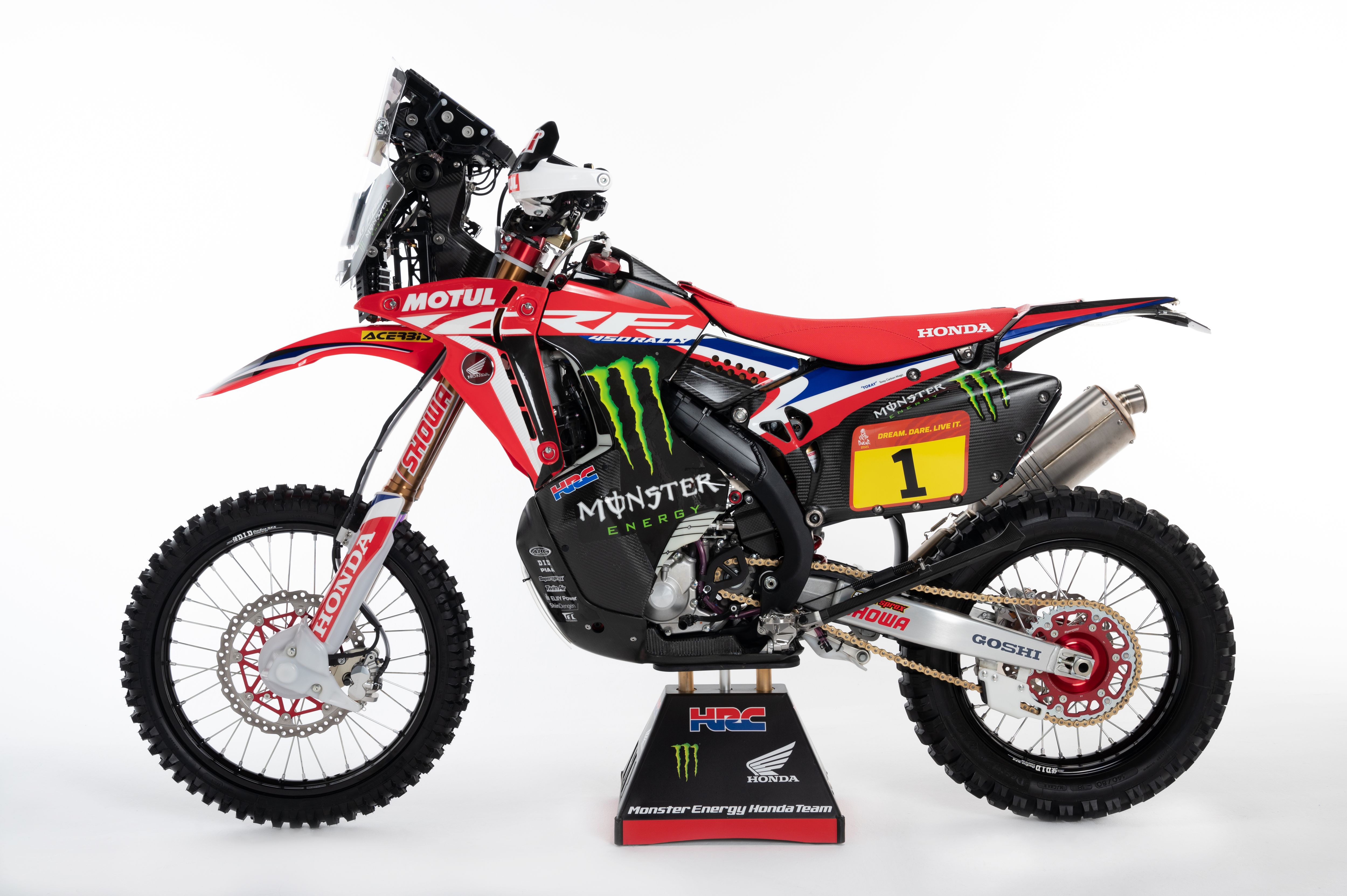Tested: 2024 Fantic XE300 and XEF310 – you really need to take these bikes seriously
Enduro21 tests Fantic’s new XE300 two-stroke and XEF310 four-stroke – two self-developed, on-the-money off-road motorcycles cementing the Italian manufacturer on the global enduro map.
Fantic might be a bit late bringing the XE300 and XEF310 enduro models to the dealer showrooms, but it was worth the wait.
You don’t have to be a genius to work out why they’ve done it either – these are core capacity enduro models and they want to up their game to challenge the biggest selling bikes on the market.
For the manufacturer blighted by the association with chassis supplier (it’s Yamaha, did you know? No-one mentions it…) these two, new flagship models are boasting loader than ever that Fantics are Italian designed, engineered and manufactured.
We cover lots of ground in this test report (its a long read btw) but have also answered Enduro21 reader questions sent in about the bikes in a seperate story: 2024 Fantic XE 300 and XEF 310 – Enduro21 reader questions answered
We finally got our hands on the bikes for a test in the mountains of north of Italy, and the Off Road Moto Park near Arco, next to the better known MXGP track at Pietramurata (home of the MXGP of Trentino).
It’s a venue Enduro21 has dropped in on a couple of times before now and knows well for its rocky and twisty course, and the fact it seems to bloody snow every time we’re there!
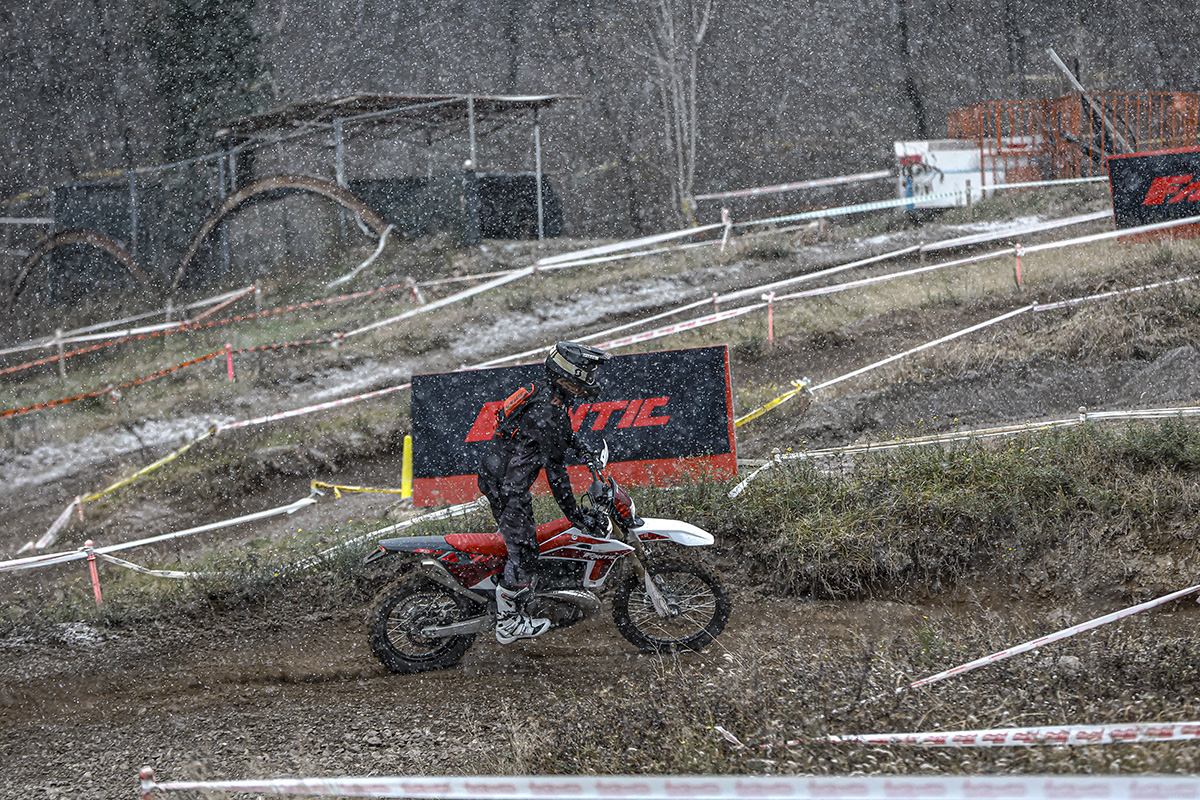
Fantic’s bold aims
Fantic might seem a bit a small player in the market to some (especially in countries where you can’t get hold of them for love nor money) but these bikes need to deliver on their promise.
Following the philosophy that it is better to do a job well first time around, and admittedly learning lessons from other manufacturers’ mistakes, Fantic has been an age delivering their XE300 and XEF310 through R&D but they are hitting two of the most important off-road nails clean on the head here.
A 300 two-stroke and a “middleweight” 310 four-stoke are the biggest-selling enduro bikes on planet earth from KTM, Husqvarna, GASGAS, Beta, Sherco and TM who are all vying for our cash in the dealers. Step up Fantic.
Ignore the elephant in the room
Fantic are no different from any other manufacturer using components from Asia in building their bikes and the connection with Yamaha is undeniable. But these two models are the very reason why you need to get over this “they are white Yamahas” trope.
The chassis components (main frames, swingarms, suspension, brakes) might be manufactured in Japan but as soon as the bits are taken out the containers in Italy, those far east origins are history.
Exit Japan, enter Europe with the Minarelli fuel injected two-stroke engine, Athena engine management systems including mapping functions and traction control on both bikes, Fantic airbox design, plastics, seats, exhausts, unique cooling system including fans as standard, handlebars, grips, wheels, tyres, electrics and lights...“designed, engineered and manufactured in Italy” is their often banged drum.
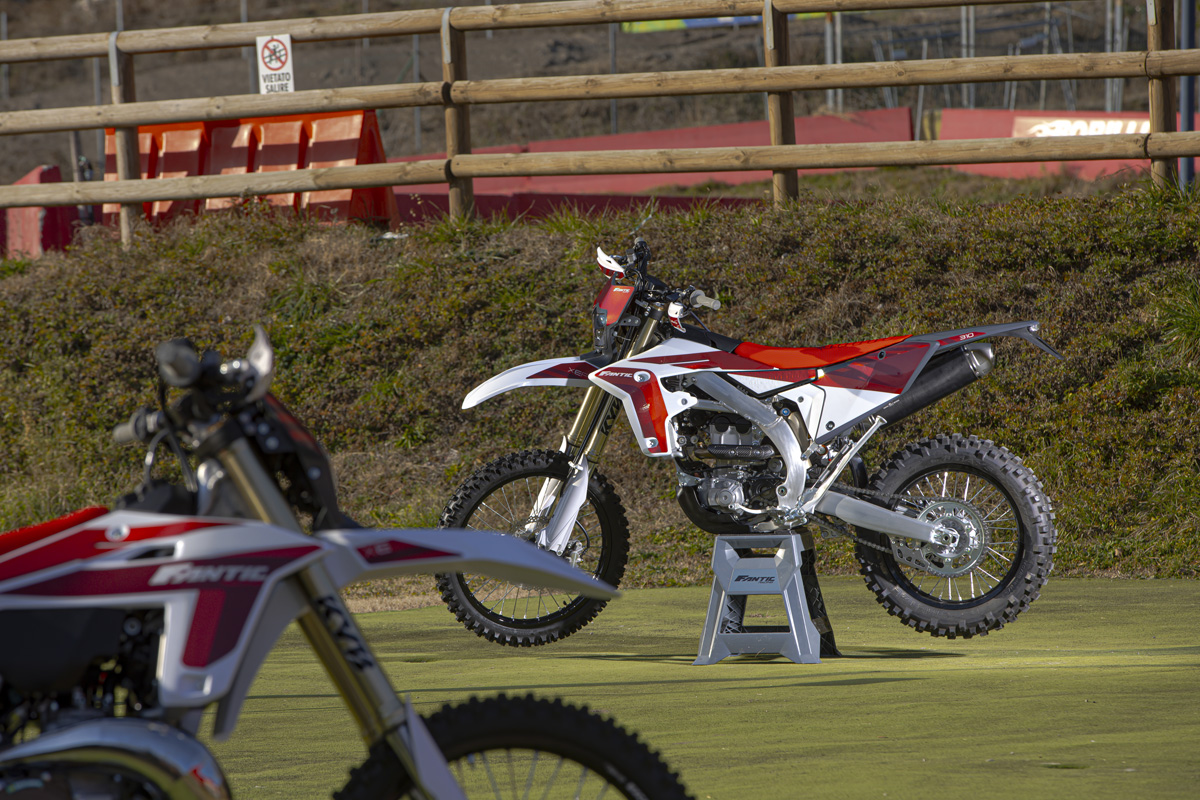
The bikes Yamaha should be building?
With that out the way, but not ignored, the first thing that strikes us as we skip around the chilly paddock, trying to warm-up, waiting for the go-ahead to hit a starter button, is that these are the enduro bikes Yamaha probably should have built. But that error is Fantic’s gain, it’s partly why they exist at all.
The 310 4T fills that gap between Fantic’s XEF250 and 450 models, blending the best of both worlds in the same way a 350 4T from Austria or a 300 SEF from France do so successfully.
The 300cc two-stroke is also right at the heart of enduro and more importantly a dramatic step away from any motocross origins you might consider the Yamaha base to have. These aren’t motocross bikes with lights on so drop that idea too.
New engine deserves applause
Always planned as a fuel injected 300 enduro bike (not a carbed model or motocross engine), we first saw the prototype Minarelli motor back in 2020 at the EICMA show.
Since that time Davide and the Fantic R&D team have been on the case.“I cannot tell you how many hours and how much work has gone into this”, is what development rider Davide Guarneri explains to Enduro21 about the new XE 300 two-stroke. We’ve built a decent enough relationship with the Italian to trust he’s not feeding us hyperbole.
These days Davide is Fantic’s full-time development rider and as such is the reason why the XE300 has been so long coming. Development speeded up around 18 months or so ago when Alex Salvini joined Fantic and took over some of the testing duties, chiefly the XEF310 and the rally bikes.
We’ve had to wait so long because they didn't want to make KTM TPI-style mistakes before sending these into production.
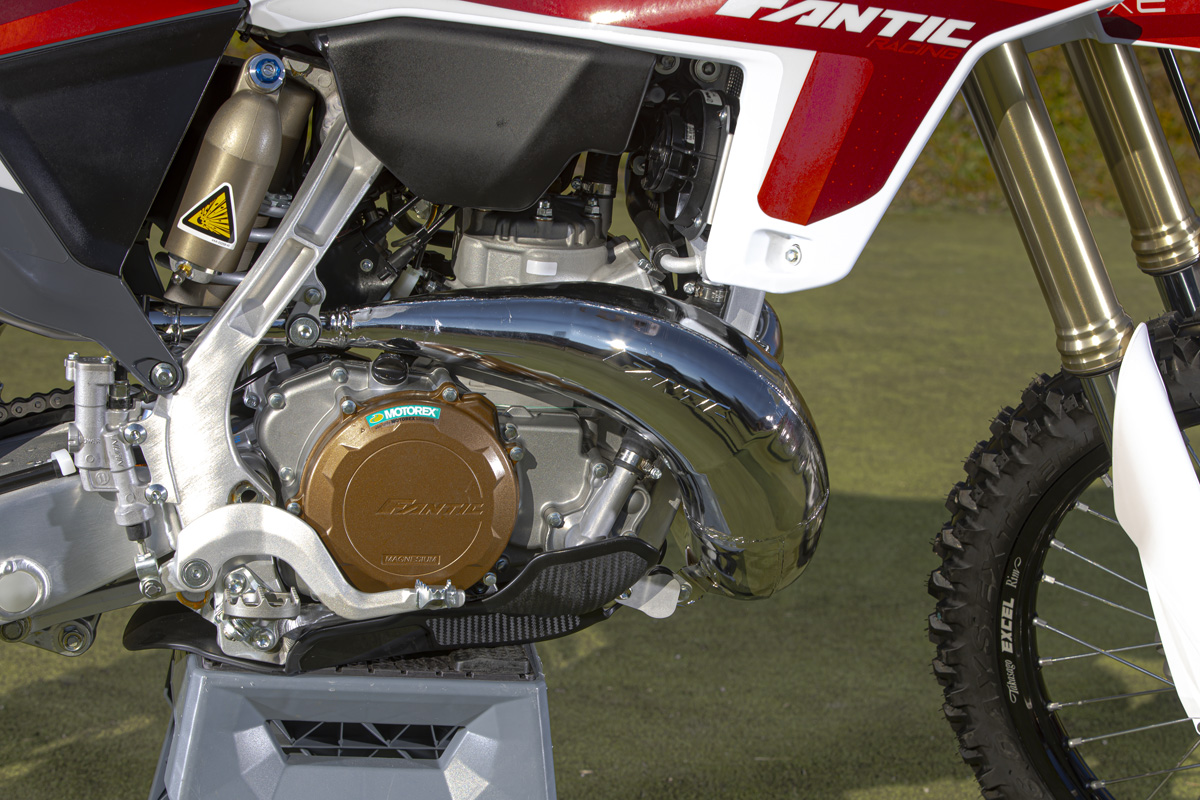
Brand new engines are rare
For the record the 300 motor claims to be the most powerful on the market, has twin throttle body injectors developed with Athena to be Euro5+ compliant, has an electronic exhaust valve to deliver a “full torque curve at low rpm”, separate fuel and oil tanks (not pre-mix), adjustable mapping and traction control with handlebar mounted switches, a hydraulic clutch and an electric start.
What’s the 300 2T engine like to ride?
To cut a long story short, and if you don’t want the long read to the bottom of this article, then the short answer is you really need to take these two bikes seriously if you’re looking at buying a new bike.
We’re bold enough to say the XE300 is rival for anything else out there because it has the power and they took the time to get the fuel injection right. The latest gen KTM engines are TBIs and loads better in terms of feel and performance in real enduro conditions than their ancestor, the TPI.
The Fantic motor is in that same TBI ballpark and feels naturally at home pulling hard through the gears, just like a strong 300 should do. Off the throttle there’s no overrunning and no lag or hestitaion when you crack back on the gas.
This test track showed us very quickly it’s also at home tiptoeing away at the bottom of the revs through a rock garden in first gear or letting you clutch it up a three-foot rock step.
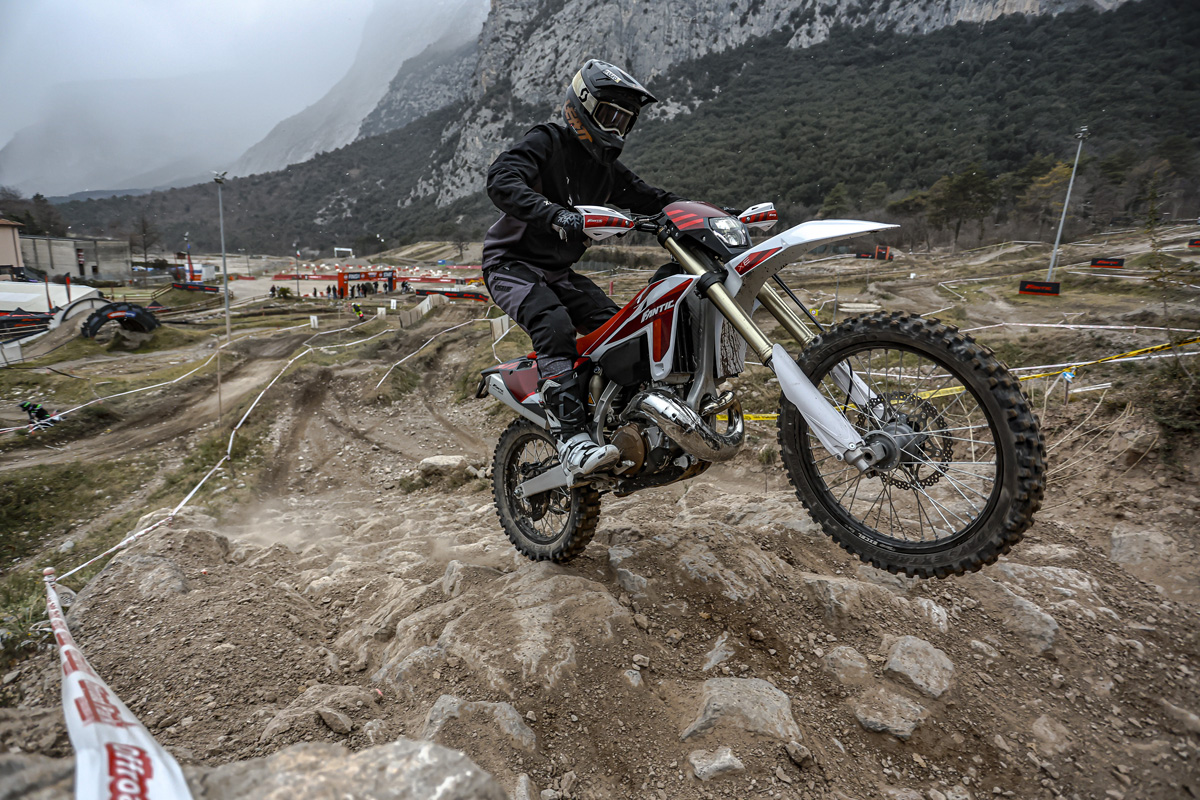
The engine and throttle response is different to a carbed two-stroke but that gets no criticism from us. Play with the app, introduce your preferred setting on your phone trackside and it feels like you can have basically whatever engine character you want.
The fuel injection and throttle response delivers lots of feel for the back wheel, which is all-important in enduro, and we’d happily take the XE300 to a hard enduro. Actually, we can’t wait to.
No six-speed?
The two-stroke still uses the Yamaha-derived five-speed gearbox and that will be a hang-up for some people. We get that. The transmission is dedicated specifically to the XE300 and they made adjustments to the Yamaha crankcases to accommodate the starter motor, but not enough to make room for a sixth cog.
The gearing in reality is a mix between parts from the YZ250 and the YZ250X with a final ratio of 14/50 (14/51 on the XEF310).
In standard set-up, first gear is a little tall for really technical riding but that is easily adjusted and our own experience with the YZ250 is that dropping sprocket sizes makes a world of difference.
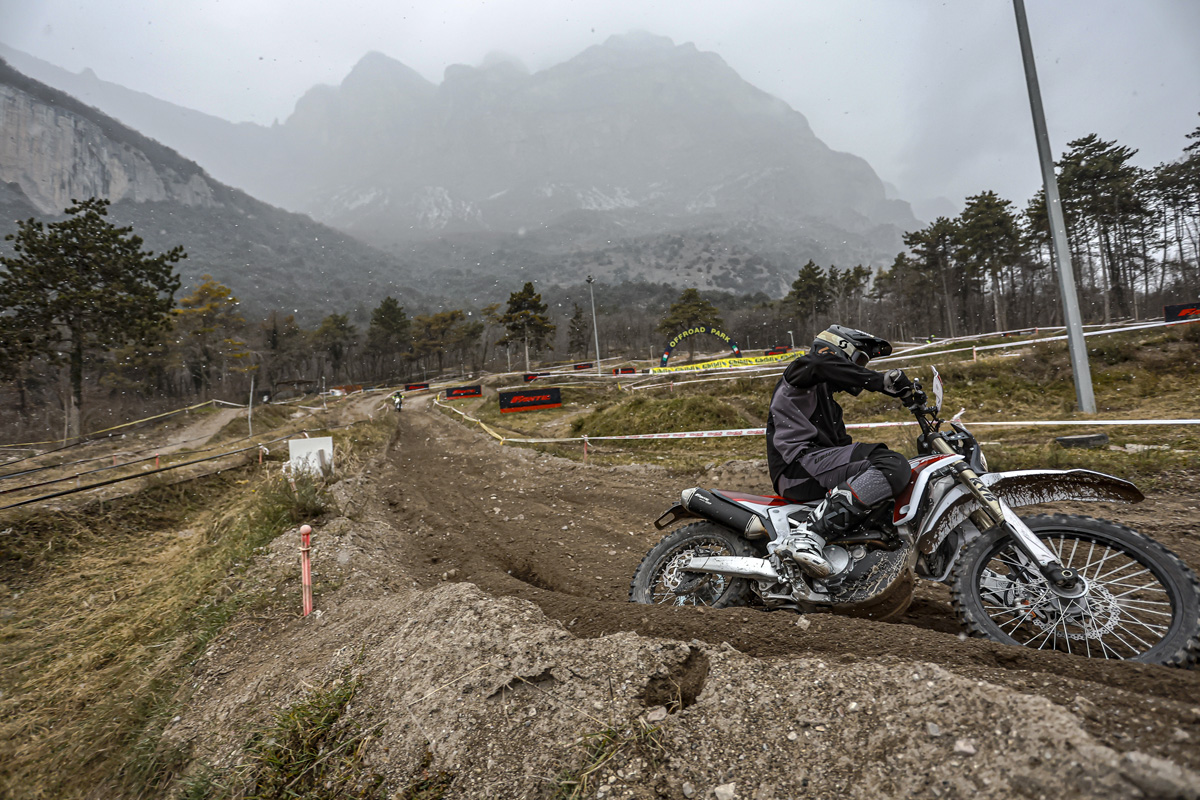
Some will miss the long top gear though and it was the one thing missing from this new bike which we never fully got to the bottom of, other than the knowledge they used the same crankcases as the 250 so basically there’s no space.
Our test session was the second day at this track and some of the previous day’s journalists reported fuelling wasn’t quite clean when they had been riding slowly.
In the cold air up in the mountains it surely would have been a day when you were clearing out the carburettor a lot with a blast of revs, but we get kinda used to that not happening with Fi bikes.
Fantic were honest with us about this and explained they had adjusted the 300 for our test session using the app to make it run cleaner, and it did.
We had none of these issues despite the weather being colder for us. The XE300 ran clean, not lean or rich, and accepted the pretty broad ridign styles we tried to throw at it.
The bottom end power is sweet and smooth in the technical stuff but is eager to be opened up and blasted through the gears and it delivers a lovely wallop of torquey drive through the mid-range. So much it was addictive. And did we mention there’s an electric start and the hydraulic clutch is lighter…
Doing the groundwork
Indulge us a little comparison between this Fantic 300 XE and our own, well-used bikes to arrive at that bold statement that “you really need to try one of these” before you buy your next bike.
Two-Strokes Anonymous Confession time: “Hi, I’m JP, the editor of Enduro21 and in my workshop I have three 250 two-strokes”. Those bikes are a 2024 KTM 250 EXC long term test bike (from KTM), plus my own 2019 Husqvarna TE 250 TPI and a 2008 Yamaha YZ250 in enduro spec (not an X model).
I’m throwing this at you to justify the bold statements and point out I’m not saying them lightly. I’m familiar with TPI and TBI two-strokes, very familiar with the old Yam and as a rule I’m also a happy 350/300 four-stroke rider in timecard enduro. The point I’m making is Fantic made two two new models bang in the middle of my radar.
I really wish my Yamaha felt like the XE300
It doesn’t take too many minutes riding to start thinking I wish my YZ250 felt like this. Electric start? Oh, yes please. More power and more useful power? Yes please. A hydraulic clutch, a cooling fan, LED lights, handguards, comfy lock-on grips, Arrow exhaust, a side stand (depending on which bike you have got), no more pre-mix? Go on then.
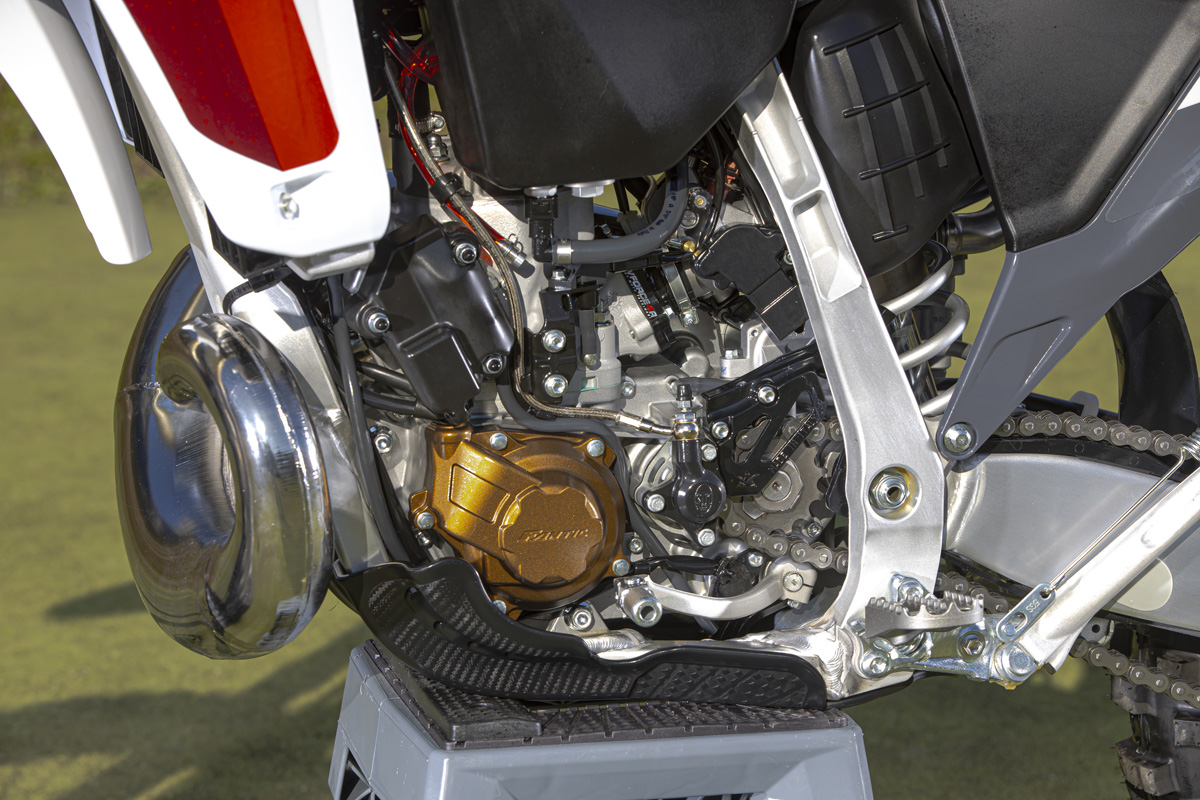
Because of all those YZ hours clocked, the Fantic 300 is immediately familiar when we jump onboard – it’s the same, old chassis after all. The general feel, how it turns, hits braking and acceleration bumps, how it holds lines and tackles the technical sections of the Trentino track are broadly the same.
There are differences between the XE300 and the XEF310 worth quickly pointing out though. The XE has basically the Yamaha frame from 2005 while the 4T models have the latest gen Yamaha aluminium main frame. To that end it means both have different feel.
Despite the different handlebar bend (the YZ250 frame on the 300 swoops up higher at the headstock so has flatter bars) you stand up on the pegs in the same place it feels like at least.
But they behave slightly differently due to weight distribution and different caster angle and trail figures (plus weight bias difference between 2T and 4T engines). 27.7°/122mm on the 300 versus 27.2°/116mm on the 310 – longer trail means more stability and vice-versa.
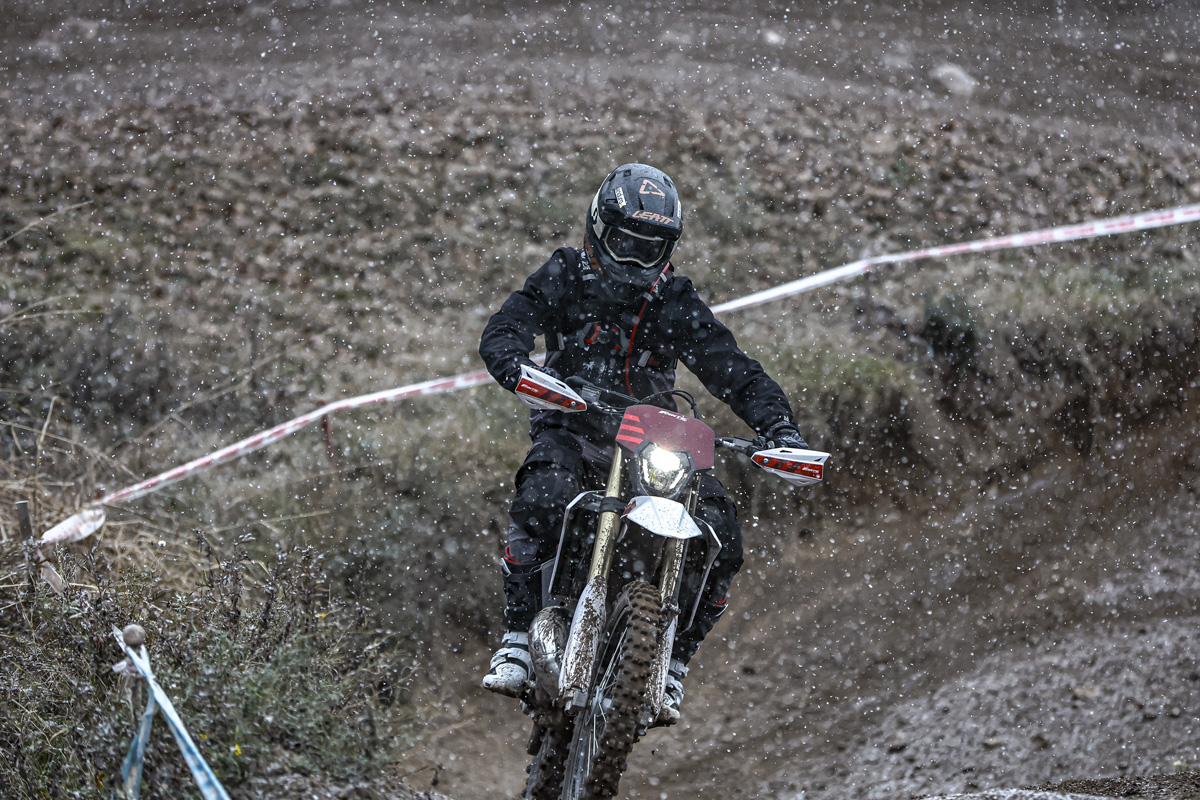
Media tests can be a nightmare for riders changing suspension settings and not returning them to standard afterwards, and this was no different which doesn’t help when you’re trying to spot the differences...
But the stock KYB suspension front and rear is recognised for its range and gives you options, in a way like the app does with the motor and power character. In the case of the 300, just a few simple changes track side can take you from hard set-up to soft set-up, both in the chassis and engine character.
Stand out feature: smooth fuelling
This test track is quite short, hard and rocky with a switchback layout which threads up and down a hill at the foot of a mountain and with a few technical rock sections, all of which is mainly ridden in second and third gears.
As a result it was a little hard to be comprehensive in our test analysis – there were no long sections where you could carry fourth gear for example, using and rolling the throttle, or anything like a cross or moto track to go flatstick, stretch the throttle cable and really feel the power through all the gears.
But it did give plenty of chance to put the fuelling and electronic system of both bikes through their paces and that feels important with these new engines.
How good both bikes fuel and respond off the throttle, especially at those points where you transition between on and off and on again, is the standout fact we’re taking away from this day’s riding.
The 310 four-stroke – Salvini’s baby
Like we mentioned about the 2T’s development rider Guarneri, there’s another very experienced rider at the heart of the 310’s development, Alex Salvini.
Alex is another Italian enduro legend Enduro21 has had a long relationship with and we trust his explanation of how hard he worked on getting, “the perfect fuel delivery and throttle response in all gears, at all throttle positions”. It was like he was talking about his own child.
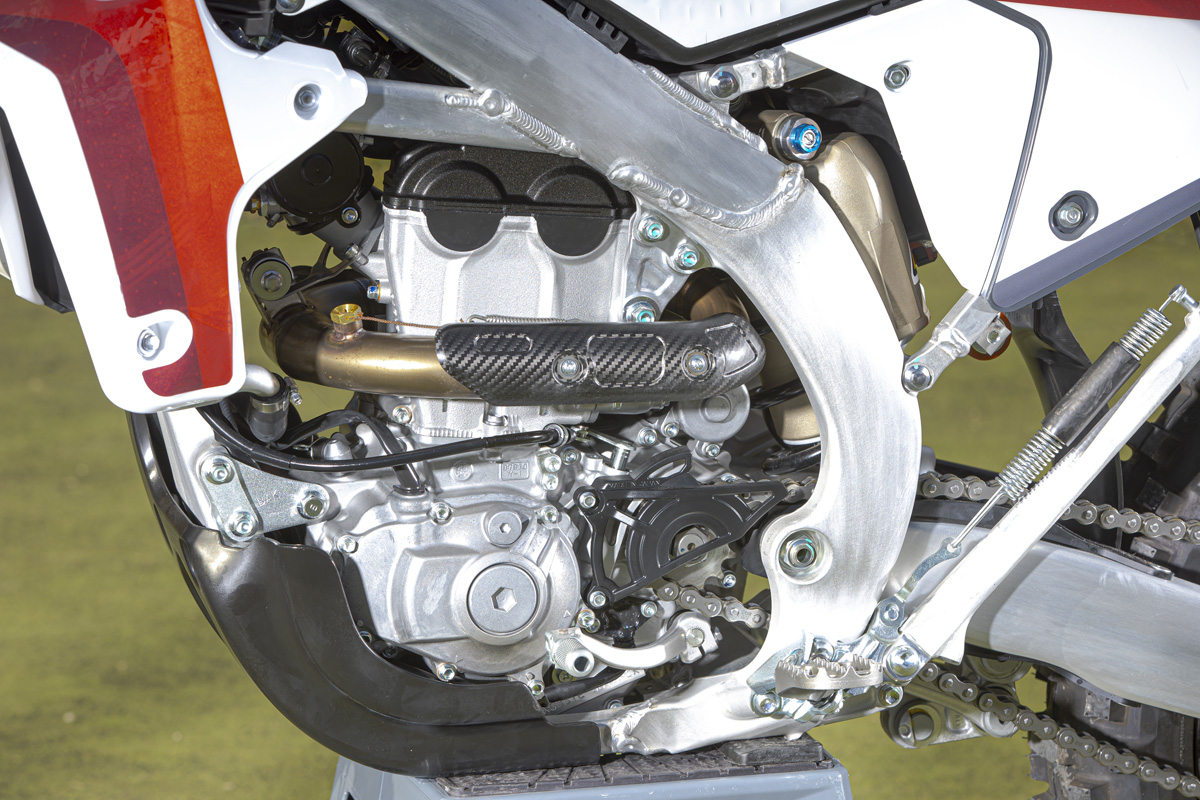
Old school big bore better than 250 and 450 4T brothers
To be blunt, Fantic’s new 310 makes the other XEF models feel a bit obsolete. The 450 now feels a bit pointless because it has too much power for anything we ever do on an enduro bike. The 250cc younger brother is great but tested alongside the 310 it now needs teh Salvini treatment on the Fi system.
We had all three XEF models to test here and the 310 quickly did that thing that all middleweight 4T bikes do; it gives you the best combination of the other two.
Unlike the heavily developed XE300 two-stroke, the XEF310 is essentially the same motor as the 250 4T but with a bigger bore. It remains a 250cc but has an 85mm bore size compared to the 77mm on the 250 (plus compression ratio is down from 13.8:1 to 12.8:1).
It’s a solution as old as the hills of course, to fit a bigger piston and bore, but like the 300 two-stroke you can feel the development hours Salvini has put in with the Athena Fi system.
It was a bike we immediately get on and felt both at home and eager to give it some. Encouragingly easy to live with is our best note in the notebook.
Jed Etchells approval rating: high
World Junior Enduro Champion Jed Etchells was on hand at this launch test and will jump from XEF250 to XEF310 in 2024 for the EnduroGP season. His quote about the switch up to the 310, “there’s no going back”, is probably all you need to hear about how good it feels.
The motor is more powerful, obviously, and more torquey where you want it. You can carry single gears longer and rely on the power to be there and pick up in a way the 250 never quite does (and the 450 does too much).
Unlike ye olde two-stroke’s chassis, the 4T’s frame is up-to-date having been developed for the latest generation of YZ-Fs. So it does feel different to the 300 with a touch more accurate steering and it moves from side to side more freely, possibly partly due to carrying more weight higher up in the engine.
The XEF310 a sharp ride then and with more meaningful poke from the engine, plus the six-speed gearbox, this is a bike which by rites will stand among the best in class. It’s as simple as that.
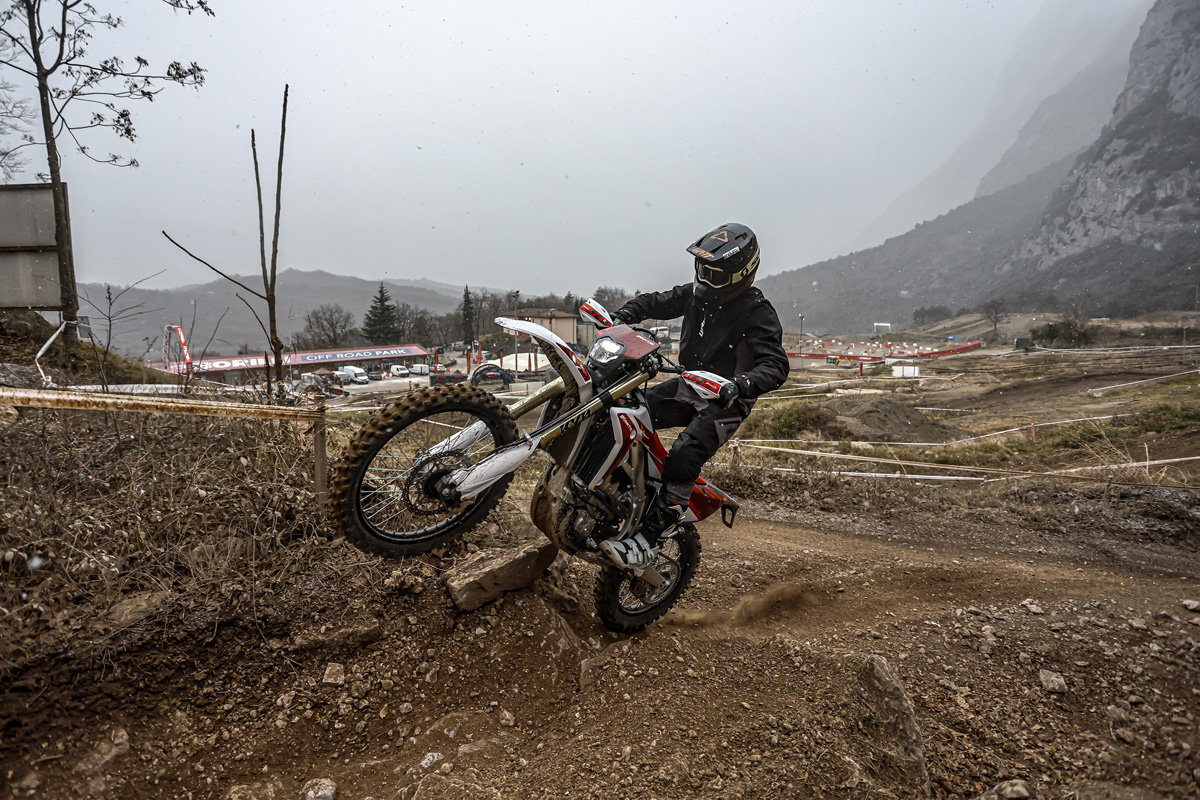 POI: cable clutch
POI: cable clutch
The XEF310 has the heavier, cable clutch system and is easier to stall. In truth the clutch lever biting point was consistent when worked hard and light enough unless you keep working it over an extended period – as ever with a cable clutch.
It is probably the only negative about the 310, if this were our own bike we’d be looking for a hydraulic aftermarket replacement to fit.
Take it in the technical stuff and, like all four-strokes, the XEF 310 is a little prone to stalling. But that’s no different to the 250 or a Yamaha WR250F and we only noticed this as much because the 300 two-stroke was easier in the same rocks at this track.
Handlebar controls
New switch gear on the handlebars for 2024 models includes a new starter button and kill switch on the right hand side, plus the traction control and engine mapping buttons on the left. The left grip is also a lock-on type which the Domino twist grip is integral.
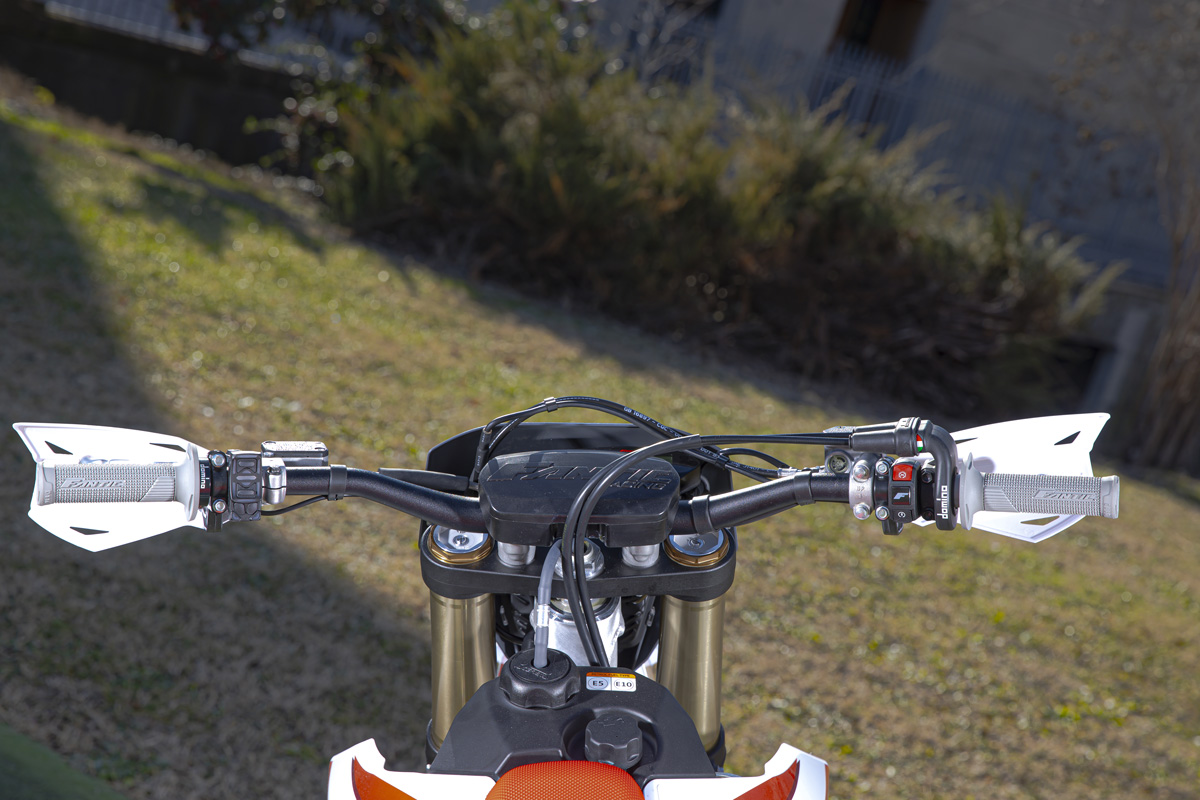
Both bikes have 10-level traction control (0 to 9 plus a “high” extra level) which we spent a good amount of time testing it to confirm it works without being intrusive.
Generally, we’re not the biggest fans of traction control on a dirt bike, that should be in your control as a rider, right? But if you’re less experienced or if you prefer to worry less about the rear wheel losing grip, the TC settings help control that back tyre.
The mapping we’ve already mentioned but safe to say combined, both proved handy because you can make a quick switch while you’re riding. That allows you to run a softer map in slick or rocky conditions and then hit the full power mode when that long-uphill straight comes into view.
Any other business? Suspension, brakes, electric start…
The rest of the components like KYB suspension and Nissin brakes are by now well documented and don’t need too much airtime from us.
It’s all good except the larger diameter discs is arguably too much for enduro and certainly it was easy to lock-up at this venue (270mm/245mm front and rear compared to 260/220mm on an EXC for example).
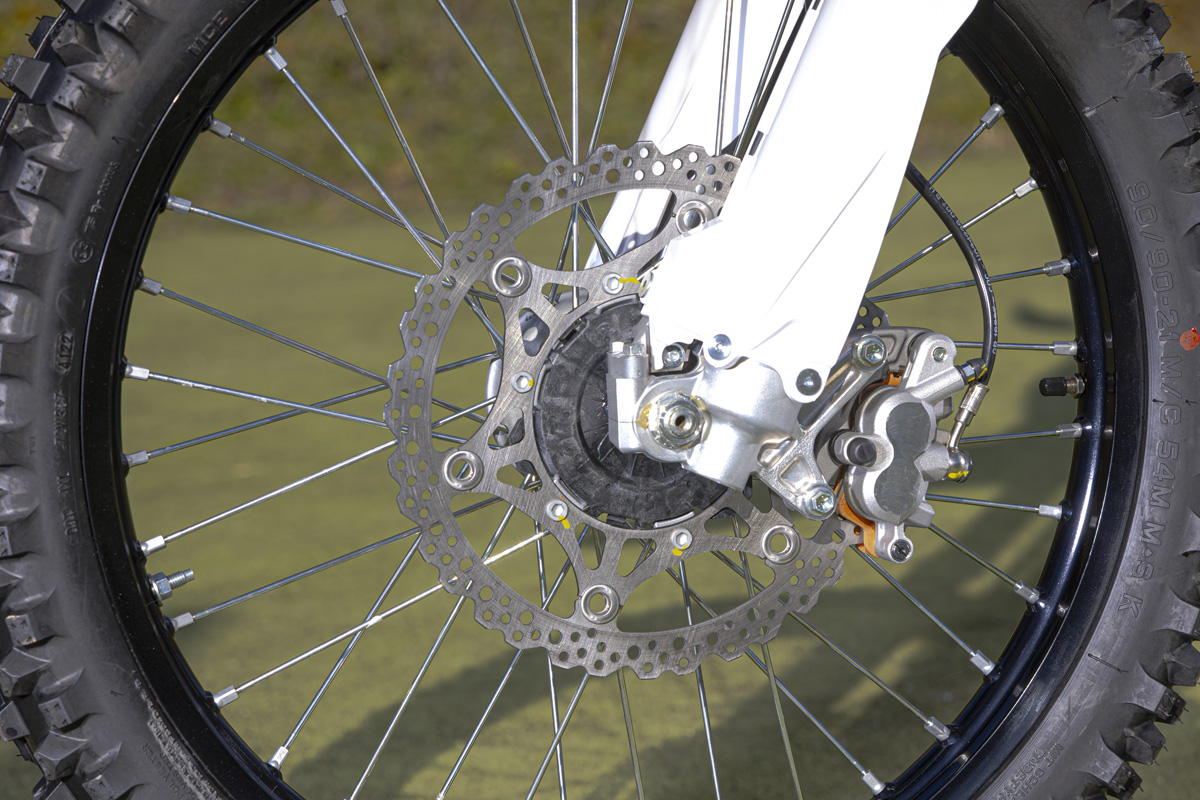
The range of suspension adjustment is meaningful though and, much like the different map settings and power options, it helps to create a bike as capable of sprint racing or trail and everything in between.
One thing of note is the 2024 XE300 gets a new, wider front fender designed to better deflect the dirt from hitting you while riding. At present it is not available on the other Fantic models but will be from next model year.
Another point gets deducted for the black Acerbis plastic tank decision. It looks neat, is unique to the XE300 and its seperate oil tank for the injection system is neatly designed. But a clear gas tank always works best in enduro so we know how much fuel we have left, everyone knows that.
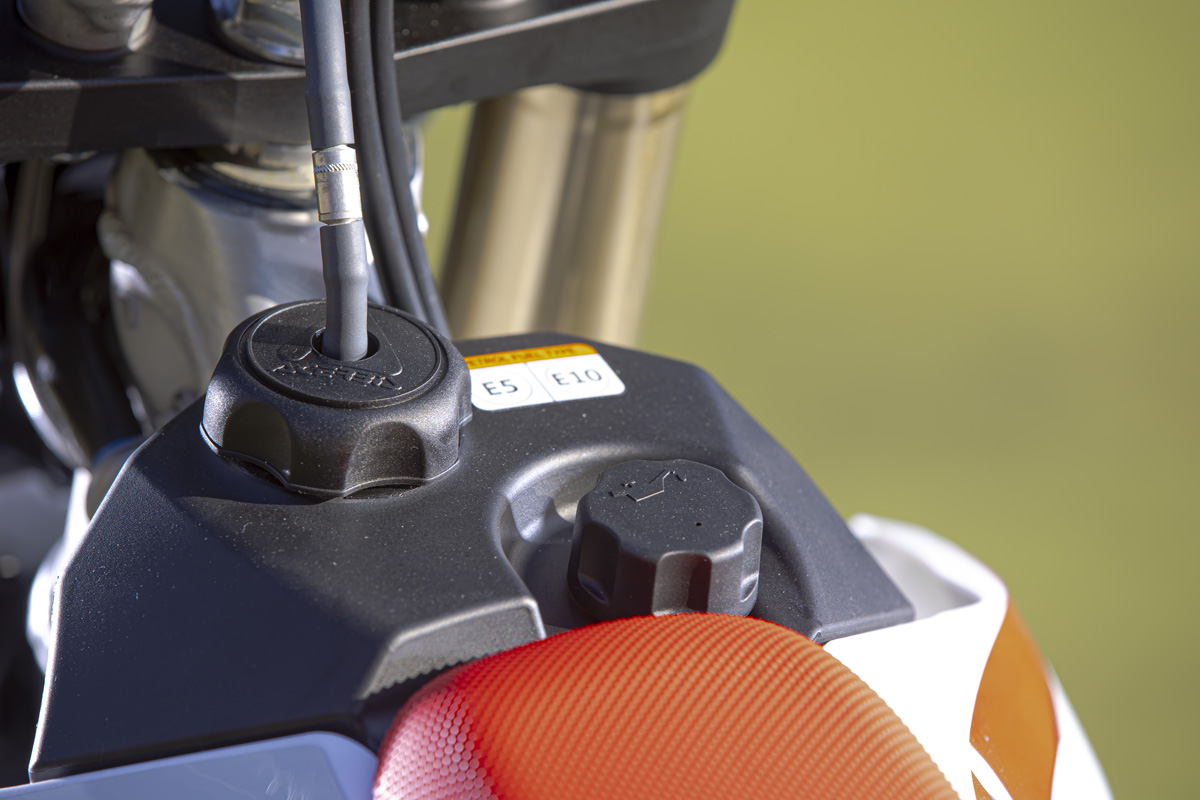
Verdict
Seriously, you need to consider these two models from Fantic if you’re thinking about a new bike.
The 300 two-stroke is exactly what we hoped it would be and answers all the questions we asked of it in terms of power, throttle feel, fuelling and abilities in as much varied riding conditions as we could muster at this test track.
The Fi performance was on-point and that mid-range was awesome to play with.
We’re keen to get our hands on one to take it to different conditions – both traditional enduro and hard enduro would be great.
The 310 is a dead simple upgrade to their 250 model but like any big-bore upgrade, it makes a huge difference to how useful the bike is real world enduro conditions. With all the electronic development from Salvini, it’s a peach to ride and will be just as useful to trail riders as to traditional enduro fans.
Enduro21 asked for your questions about the new Fantics – thanks for all the comments. We’ve put the best and most common (incl. why not on sale in North America) into a separate story: 2024 Fantic XE 300 and XEF 310 – Enduro21 reader questions answered
Prices: Fantic XE300 £9499/€10,390
Fantic XEF310 £9599/€10,790
(prices may vary across Europe)
2024 Fantic XE300 specifications:
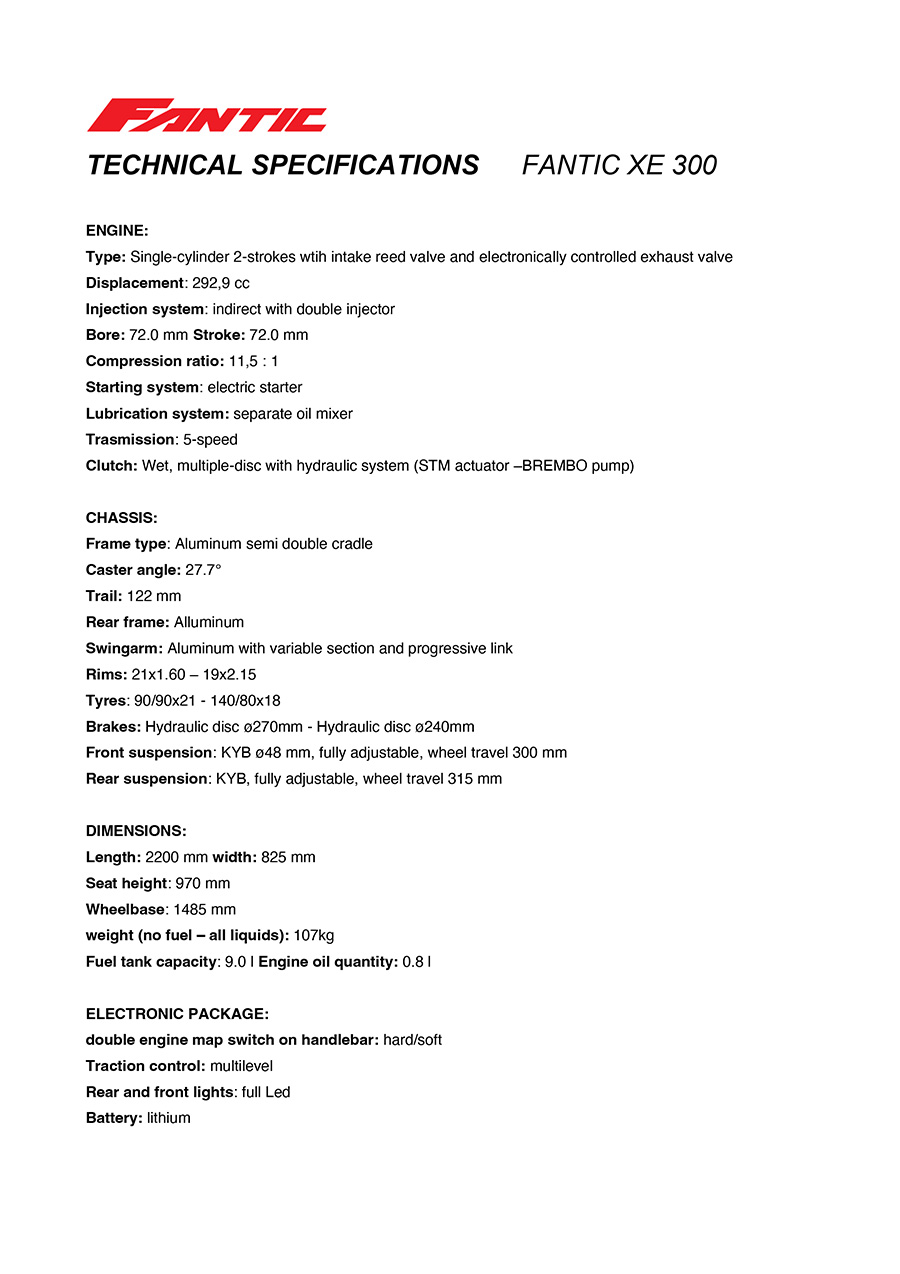
2024 Fantic XEF310 specifications:
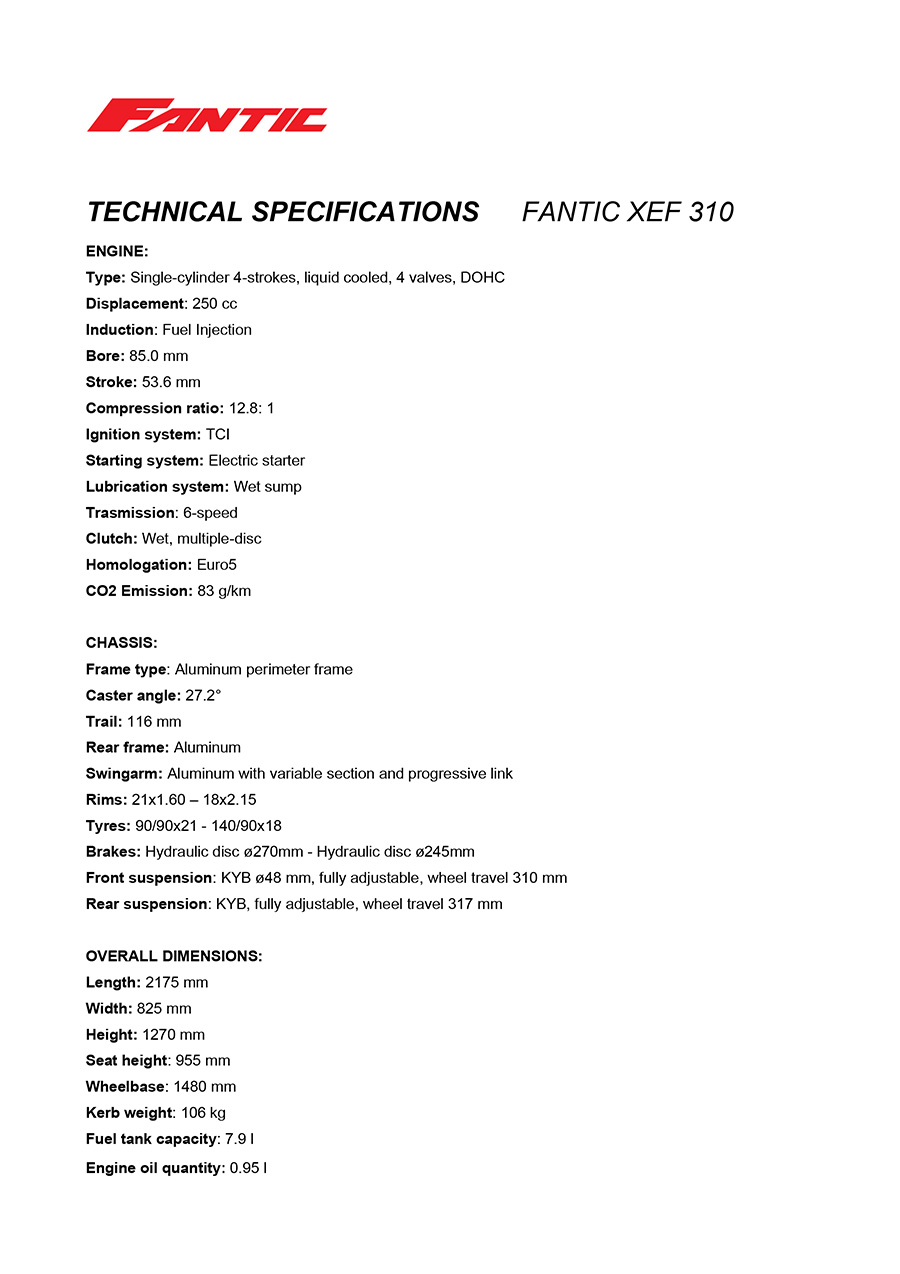
Photo Credit: Cristiano Morello




